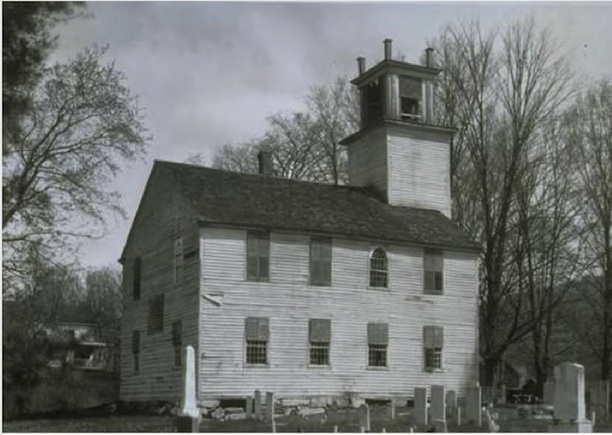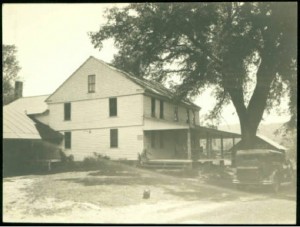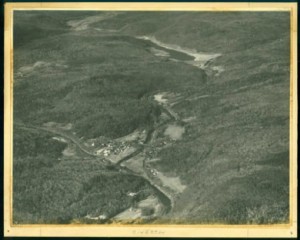by Kevin Murphy
From 1927 until 1948, the Metropolitan District Commission (MDC), using money from the sale of water bonds, purchased landholdings in the East Branch valley of the Farmington River, built the Saville Dam, and then flooded the valley to create the nine-mile-long Barkhamsted Reservoir. The project, though worthy, displaced more than a thousand people who lived in the hollows. This is their story.
As the East Branch of the Farmington River tumbled swiftly through northwestern Connecticut area residents gave it little thought. They fished it almost year-round, catching trout, small-mouthed bass, and pickerel. Nights, bands of small boys would sneak up to the “black pool” near the Old Newgate Coon Club and fish for bullheads which when cooked properly, tasted every bit as good as trout. No matter the species of fish, the East Branch provided a feast for the hungry.
There were two separate hamlets in the East Branch valley: Barkhamsted Hollow on the south end of the valley and the smaller Hartland Hollow in the north. Residents built small bridges to ford the river which flooded its banks in the spring and kept both people and farm wagons close to home. The children loved the flooding: until the water receded, schooling would be limited. For farmers, though, the annual spring flood simply marked the beginning of another growing season. In addition to keeping dairy cows, sheep, pigs, and chickens, residents also raised tobacco, silage corn, potatoes, hay, and a large market basket of vegetables for their personal use.
Daily Life in a Small Community
News from the outside world, following a path dictated by the terrain, flowed up the river from the town of New Hartford through Barkhamsted Hollow and up to Hartland Hollow. Babies in the two hollows were delivered at home with a doctor visiting as soon thereafter as possible. The physician might travel from Winsted or New Hartford, the two slightly larger towns to the south. For many years, it was the unflappable Dr. Chester English who drove his horse and buggy from New Hartford to the farms in the valley.
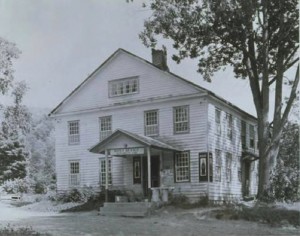
Photograph is most likely of the Barkhamsted Hollow Post Office, which was demolished in 1930 when the site was flooded to create the Barkhamsted Reservoir – Connecticut Historical Society
The principal fixture of Barkhamsted Hollow was LeGeyts, the only general store in the valley. It was located at the intersection of East Road which ran along the river and Washington Hill Road, the unofficial line between the north and south sections of the hollow. The store was a tiny but surprisingly complete operation, selling household goods, meat, produce, and hardware. It also had a fairly large feed and grain department and housed the local post office.
When they started out in 1918, the LeGeyt family lived over the store, but a few years later an unusual opportunity arose. Thanks to Prohibition, Merrill Tavern next door effectively went out of business. Charles and Mae LeGeyt turned the old building into a home. Beginning in 1927, 14-year-old Laura LeGeyt began helping her parents at the store, delivering sacks of grain and groceries up and down the valley. As long as there were men to offload the heavy hemp bags at their final destinations, she could muscle the family’s aged Reo Speed-Wagon along the dirt roads. Usually with 15 to 20 sacks per trip, the battered truck put in a long day with the unlicensed Laura at the wheel.
In Hartland Hollow, there were about 25 farms and private homes. Some sat on parcels of land as small as a few acres, while others rivaled Augustus Feley’s 345-acre spread. Like Barkhamsted Hollow, Hartland Hollow was divided between the north hollow upstream of Route 20 and the south hollow downstream. Route 20 descended the mountain from the west more gently than it did in the east, the beat-up, narrow macadam road making an almost straight shot directly into the valley. Conversely, Walnut Hill Road on the east was a ledge cut, which snaked back and forth across the mountain between trees and boulders until it finally straightened for a quick run through a 30-foot-long covered bridge over the river. In the springtime, the beautiful rose-colored flowers of the trailing arbutus bushes completely blanketed the mountains on both sides of the valley.
By today’s standards, life in the hollows was harsh. There was no indoor plumbing or heating except what could be furnished by wood-burning, cast-iron box stoves. To keep warm at night, children wrapped a towel around a flat iron or a heated brick and took it to bed. On Saturday nights, hot water for baths was taken from a side tank on the wood stove and poured into a galvanized tub. There was no electricity therefore there were no radios, telephones, or electric lights. Most people used kerosene lamps. Little did residents know that their simple, bucolic life would soon come to an end.
The Beginning of the End
The Metropolitan District Commission (MDC) began acquiring landholdings in the East Branch valley in 1927, three years before the state legislature gave the agency permission to impound the waters of the Farmington River. The first farm acquired late in 1927 was the Stewart farm in Hartland Hollow. The Stewarts, together with their son, daughter, and six grandchildren, were allowed to remain on the property for another six years while they looked for a new place to live. A month later, Mrs. Joanne Carrier sold her farm to the MDC and moved with her two daughters to Riverton, in the valley of the West Branch. Late the following year the MDC bought two more farms: the 220-acre Waldo Miller farm and the 256-acre Wilber Miller property.
Two-and-a-half years after the first purchase, and just before the General Assembly granted the MDC its charter, the agency bought J. Alfred Cables ‘s 200-acre spread. The Cyrus Miller Tavern -and its 20 acres-followed. Things moved quickly for the MDC now, as they picked up Anna Schramm’s 80 acres in April 1930 and the Fred Stevens farm (95 acres) two months later. Just before Christmas, the MDC bought the 43-acre farm where young Pauline Emerick had watched her house burn to the ground just six years before.
While the MDC purchased the farms of Hartland Hollow in the late 1920s, the agency also was negotiating in Barkhamsted Hollow but only a few Barkhamsted farms changed hands at that time. It was during the 1930s that the bulk of these sales transpired, with a total of 80 properties coming into the hands of the water company.
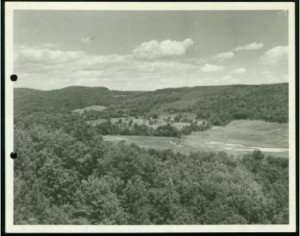
Metropolitan District Commission Reservoir Basin, ca. 1940, Barkhamsted – Connecticut Historical Society
In June 1931, the MDC bought 208 acres from Leon Dickinson in Hartland Hollow and, a month later, the Clifford Cables farm (140 acres). Soon thereafter, the MDC closed on still another large piece of property-Byron Stratton’s place-gaining 344 acres.
Some sales affected folks more than others. It was an enormous blow when the 160-acre Talcott Banning farm was sold. On the surface, it might have looked like the loss of just another homestead, along with the usual livestock until one considered the owner’s little sideline: Banning ran an illegal distillery. During those thirsty Prohibition years, he produced enough hard cider and apple brandy for everyone in the hollows.
Just before Thanksgiving 1931, it was Augustus C. Feley’s turn to sell his land. He did so in a big way, because he owned two farms. He sold his own place (345 acres) and the smaller Robert Stewart, Sr. farm. Feley was a practical man. Sensing the futility of a long, exhausting battle-with a preordained outcome-he simply accepted the MDC’s offer and moved on.
Early in 1932, the Metropolitan District let the contract for the clearing of the site where the new Saville Dam would be located and, in January, held a most unusual meeting at The Hartford Club. The desperation of the times was evident as MDC Chairman Charles Goodwin announced that, owing to the horrendous condition of the bond markets in New York, he would have to call a halt to the land purchases in the East Branch valley. However, exactly two weeks after the water board voted for a moratorium, they received an offer of sale from the heirs of the Ford Brothers farm, and they were back in the land-buying business.
Not all land transfers went smoothly. At a meeting in late 1932, the board faced an ugly task: condemnation. Two property owners in Barkhamsted Hollow had decided not to sell. The first, Charles LeGeyt, was the secretary and treasurer of Barkhamsted and by all accounts a good-natured and reasonable man. He and his wife, Mae, had acquired about 120 acres, their home, and the store, and they were determined to stay put. The LeGeyts held out for almost two years.
Unfortunately for the LeGeyts, so many folks had sold out that business had slowed to an occasional order from their neighbor, Harold Birden , the other holdout. Still, true to the spirit of the protest, LeGeyt ‘s Store remained open until November 1934, when Charles and Mae finally sold. Harold Birden was made of marginally stronger stuff and lasted until April of 1936. He was the last to leave Barkhamsted Hollow.
Meanwhile, in Hartland Hollow, the Old Newgate Coon Club turned out to be the last private building to be surrendered. The 100 members of the club were mostly from Granby, with a smattering of men from the hollows. After considerable negotiations, the Old Newgate Coon Club, together with its 89 acres, was sold to the MDC for $24,000.
After everyone was out of the valley, in the early summer of 1936, SJ Groves, a stripping company from Ridgefield, New Jersey, descended into the hollows. The contract called for scorched earth in the 1,100-acre basin where the reservoir would sit. The work began in November and was completed the following August. Times were tough, and local people were not too proud to work for Groves, sometimes stripping land formerly owned by their own kin, neighbors, and friends. Using two-man whipsaws, the 75 workers felled towering hardwoods from morning to night. Trees, brush, house parts, barn wood, and old farm implements were stacked in an enormous pile in the center of A.C. Feley’s former tobacco fields. A local man, Paul Crunden, estimated the pile to be 60 feet tall and said that when it was set ablaze the flames “licked the clouds.” By the time Groves was done, there was nothing left in the valley but empty cellar holes.
The Last Dance
The MDC had told the residents of Hartland Hollow that their town hall would be the last building demolished, and the agency kept its word. The former residents wanted to have their 1940 Halloween dance in the old building. Former neighbors came from far and wide in their old Fords, Chevrolets, Plymouths, and rusty farm pick-ups. After selling their land, most folks had bought new farms and started over. They’d moved to Granby, Suffield, Winsted, New Hartford, Riverton, Pine Meadow, and Canton.
A short time later, and just ahead of the rising waters, the MDC gave the order and the 80-year-old town hall was burned to the ground. Eventually Hartland Hollow slipped beneath the waters of the Barkhamsted Reservoir, but the whole nine-mile-long catchment took eight years to fill. Water finally crested the spillway at the Saville Dam for the first time in 1948.
While the MDC’s new reservoir was essential to the denizens of Connecticut ‘s capital region, it created great hardships for the people in its path. The Barkhamsted Reservoir displaced upwards of 1,000 people. The families of the East Branch valley were not the only people uprooted by reservoir projects, however. Over time, thousands more were displaced by similar work in New York, Boston, and dozens of other cities in the US.
Kevin Murphy is the author of Water for Hartford: The Story of the Hartford Water Works and the Metropolitan District Commission, from which a version of this story was excerpted.
© Connecticut Explored. All rights reserved. This article originally appeared in Connecticut Explored (formerly Hog River Journal) Vol. 4/ No. 1, WINTER 2005/2006.
Note: ConnecticutHistory.org does not edit content originally published on another platform and therefore does not update any instances of outdated content or language.





